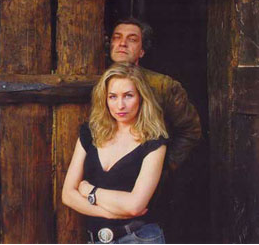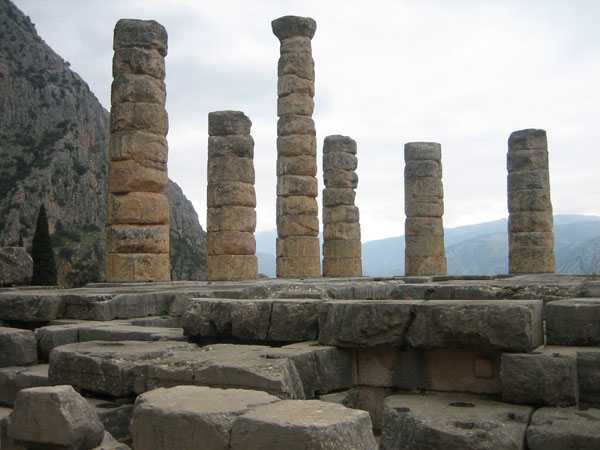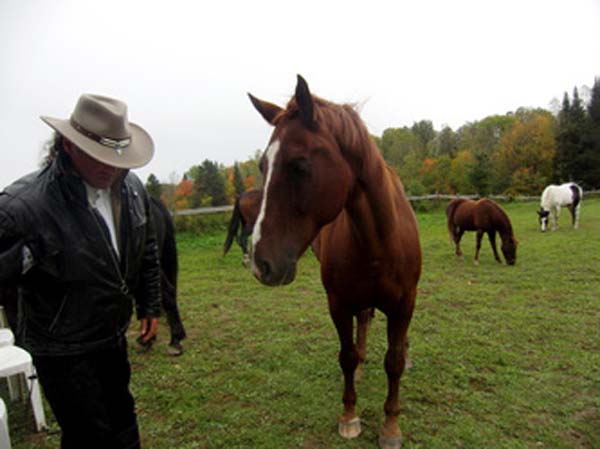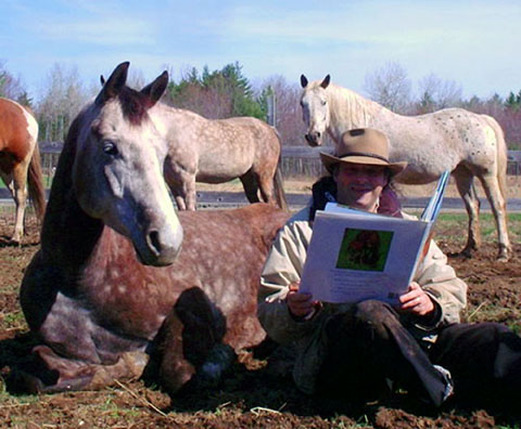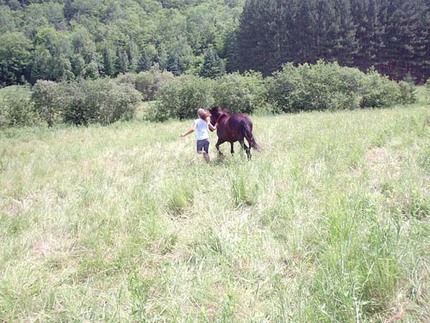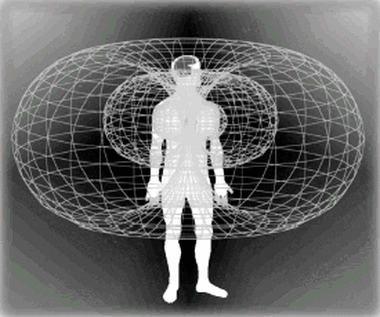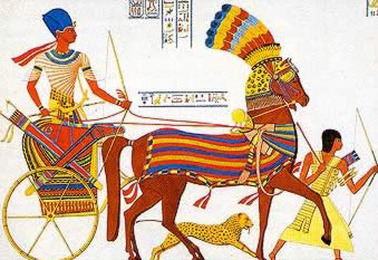Under ongoing construction - Watch out for incoming photos
by Michael Bevilacqua
December 2011
It is a special time of year that still holds some kind of childhood magic for me. Although what Christmas represents is important, I do not view it in the overall strict religious sense. I became disillusioned in my birth religion as, at the very least, symbols and dates were changed long ago to accommodate other rituals and assimilate people. It has astounded me to what extent history has been rewritten by men in power in order to manipulate and control the people. How do we know what is true anymore? No matter where we come from there is a fundamental truth shared within all our hearts. That is what counts.
I have personally designated Christmas as a special time, of all other times, for reaching out to others, sharing, appreciation of those around us, compassion, love and with a hope that this will be the year that the animals can talk at midnight!
A lot of people find themselves struggling against an imposed, fixed structure within their lives. Over time they may question what was learned in the way that they were raised. It could be regarding politics, social status, race or religion. It is no different in regard to views about horses.
I believe that love is universal and that lack of it can twist us or deform us inside, in some way. After all, is not that what all comic book villains are based on? Sometimes, fact is stranger than fiction.
There have been stories of people noticing horses unattended in a field and starving. The ongoing situation is eventually mentioned among themselves. Does anyone go to the house of the owner to see if everything is ok? Does anyone take it upon themselves to throw some hay over the fence? People stand by and watch until the horses are near death or some lay dead and only then, call some ‘authority’. Of course, there are cases of outright neglect by belligerent owners, but I know of a case described as above where the horses were not tended to because the owner suffered a stroke in the house. No one ever checked. People were stunned; blamed each other but it was too late for a happy ending.
All that is necessary for evil to succeed is for good men to do nothing. (Edmund Burke)
It is easy to pass the buck or point the blame but as part of society, we have responsibility for society and we have power to make change and even a simple act or gesture can mean the difference to someone’s life. It is responsibility of love and caring, not accusation.
In `Beyond the Dream Horse`, it is mentioned that we have the habit of separating ourselves from all around us – as if we are independent, aloof, better, superior or even invincible. I write of being in the moment; being part of nature and how what we often seek so earnestly in a desired connection to horses we have already experienced when we were children. The results often disappear as we progressively become part of the man-made world, but amazing relationships with horses need not remain in storybooks.
In wanting to work with horses it is imperative that we first work on ourselves. If you can sit quietly and think about how you truly are and what you want with horses, without judging your thoughts but simply being aware of them, this can bring you clarity. What you know, what you like, what you do not like, what you have done, actions you regret, how you wish it may be different... It can put you at peace with yourself and allow you to move forward.
One of the greatest scientific minds of the 20th century had a quite pragmatic view of personal development:
A human being is part of the whole called by us universe, a part limited in time and space. We experience ourselves, our thoughts and feelings as something separate from the rest. A kind of optical delusion of consciousness. This delusion is a kind of prison for us, restricting us to our personal desires and to affection for a few persons nearest to us. Our task must be to free ourselves from the prison by widening our circle of compassion to embrace all living creatures and the whole of nature in its beauty. The true value of a human being is determined by the measure and the sense in which they have obtained liberation from the self. We shall require a substantially new manner of thinking if humanity is to survive. (Albert Einstein, 1954)
There are many times that, I must admit, my faith in humanity begins to wane. Just at that time, however, there is someone, somewhere who restores it.
In the French edition of Readers Digest, there is an article written by Simon Hemelryk. It is translated to `Dial H For Honesty`. This was a test where 30 cell phones were left in 32 cities around the world. The goal was to see how many of the 30 phones in each city would be returned to the owner.
Number one was Llubljana, Slovenia where 29 were returned. Toronto, Seoul, Stockholm and Montreal followed with 28, 27, 26 and 25 respectively. Full results can be found at the Readers Digest website (UK). Even the worse results are not too shabby. The English version is available online and the link is provided in the references section at the end of this article.
We are bombarded daily with news and it is compounded due to instant access from around the world. The most sensational news gets out first and is usually the bad news. In our daily lives we offer so much better and it should become more commonplace.
Catherine Scott, of the blogspot, Of Horses and Humanity, once asked me to write what sanctuary means to me. I was surprised what came forth from my thoughts and sent it on. Catherine is direct but thankfully, (or perhaps, graciously) she said that she liked it. This is not everyday writing but can perhaps help give you an idea of what I mean about being truthful with and accepting or changing yourself:
The space within my heart is hushed stillness or silent dialogue
Or filled with despair or love’s anguish
Inspiring limitless hope or creating tears so full of emotion lips can only serve to taste them
It is a vastness to be found when all the walls are closing in
Glory and all worldly fortunes have no meaning there
A sanctuary as a castle chamber of cold stone warmed by fire’s amber glow
Illuminated by the ever increasing lit number of candles with every life experience
A place of solitude and respite with ghosts of my past and errors lingering in every corner
Allowing and without judgement
It is a pillow to refresh my tired soul
As people, we all share this deep inside. This has nothing to do with mysticism. This is all regarding a certain way of being which, in turn, allows a way of being with horses. Allow your brain to change your ‘mind’ and you will notice a change in how horses are around you.
Such advice is not an instant fix, but it is definitely a noticeable one! This is good to help all people begin to find self-clarity and direction. It is honesty with yourself. If you can accept that then you will be less critical with others. This will make you happier and allow you to focus on the better things. That is the first step. I write and talk of being on a `level playing field` with horses or simply viewing them as different types of ‘entities’ with whom to connect. Respect is important. It is respect of nature, including horses and this includes yourself.
We are but one thread within it.
Whatever we do to the web, we do to ourselves.
All things are bound together.
All things connect.
Chief Seattle, 1854
Lana Allen: InnerSelf.com: Know Thyself
Albert Einstien: SpaceandMotion.com: Albert Einstein: God, Religion and Theology
Simon Hemelryk: Readers Digest : H is For Honesty
Catherine Scott: ofhorsesandhumanity.blogspot.com
Michael Bevilacqua: Article Series - April 2011: The Missing Link
Native American Quotes: Pearls of Wisdom
The Human Masquerade
by Michael Bevilacqua
November 2011
In the everyday world of smalltalk, my answer to that question is, jokingly, ‘Irish’. No one knows the silent answer within my head or how it hangs heavy on my heart.
Things are so simple when with horses. Honest and straightforward. I can joke with them if I want to, and sometimes do. They showed me that. I can be myself no matter how I feel with no need to explain. No matter what, they can see me, sense me and accept me.
Your body language is important and has to go with how you feel. It is when you are sure of what you are doing and not even thinking about it, that you unknowingly enhance communication through accompanying body movements.
It might be good to have an understanding of how horses interact with each other or their body language but leave that behavior to the horses. You can still fully understand each other in the way that you interact. It is intent that is most important, conveyed and received by the horses. This holds true even in the wild. I have seen photos of a mountain lion lazily grooming herself amid a herd of grazing horses. There is a photo series of three cheetahs that overcome a young impala but since they were not out looking for a meal, they played together and groomed each other. That was the main, touching image portrayed across the internet. However, there appears to be a picture missing. The impala eventually runs away, instinct kicks in all around, and the impala is brought down by the cheetahs. Such is reality in the wild.
We may be predators and certainly have a constant history of absolute attrocity but our saving grace is the compassion and love we also possess. It is important to just be yourself. Let the horses just be themselves. Stop analyzing every situation or movement. If you have that frame of mind of working with an ‘animal’ or using ‘herd behavior’ you will be stuck in that rut. You are going to have trouble in advancing on the relationship and honest comprehension level. Even worse, the horses may be showing something to you, right in front of your eyes, and you will miss it because you are not open to the possibilities. It should be clear that this is not a training method. It is live interaction and on-going learning between you and the horses.
Everyone has experienced it at some time even when, on the surface, things seem to be really good or as we want them to be. Yet, there is a funny feeling in our gut, fluttering in the chest or sweaty palms or just some fleeting, hidden thought within us that we choose to ignore.
It was always believed that the heart responded to the information sent to it by the brain. Going back to Hippocrates there were those who believed that the heart served a much greater function. Certainly, that stress and different kinds of emotion affect the rest of the body in various ways. Dr. J. Andrew Armour of the University of Montreal discovered in 1991 that the heart has somewhat of a brain of its own. A network of about forty thousand neurons has been discovered within the heart muscle. It has its own memory and can act independently from the central nervous system. These send signals to the brain and can alter the state of the brain in its wave activity. It does this in four ways: neurologically (transmission of nerve impulses), biochemical (hormones and neurotransmitters), biophysically (through pressure waves) and energetically (through electromagnetic field interactions).
What is also intriguing is the continued work at the Institute of HeartMath located in Boulder Creek, California. The body has its own voltage and sends out info in a radius from the chest toward the skin and further that can be measured (EKG pads that are placed on the torso, for example) The heart can pick up information from the external environment as well and send us signals that can commonly be described as intuition. A situation may appear to our eyes and brain as normal or good, yet, for some reason, there is a funny feeling inside of us that is telling us otherwise.
There were so many times, with horses, that I made a decision or understood something regarding the horse, without being able to explain it. It is important to note that intuition is best described as a sudden, unexplainable awareness rather than a feeling. It is not an emotion that suddenly floods us. If you have a feeling of fear, for example, that is not intuition. Rising emotions in us are linked to our thoughts. If intuition signals danger, that signal, of itself, is just something that suddenly occurs to us. It is then that fear can quickly follow due to our thoughts presenting conjecture based on that danger signal. With intuition, questions come after the answer.
Electroencephalograph (EEG) and Electrocardiogram (ECG) will tend to match each other in rhythm patterns either within one person or between two people if they are in close proximity but more so when they touch. This tuning of rhythm between heart and head also results in improved cognitive performance. This exchange of energy into other living tissue also produces a strong theory about the practice of healing.
Intuition is not a training method, either. However, if you can be observant without any kind of preconceived notions about what your horse may or may not be doing, it could permit you to get a clear message. Or easily allow a solution to how to get one across to the horse in a different manner. Focusing on something that may normally come naturally can sometimes get a person quite confused.
The centipede was happy, quite,
Until a toad in fun
Said, “Pray, which leg goes after which?”
This worked his mind to such a pitch,
He lay distracted in a ditch,
Considering how to run.
I toyed with the idea of what it would have been like for the very first person to have a horse willingly allow a touch. How about getting onto a horse’s back? Why would a person do it and how did it go? Did it somehow happen by accident? A human folly? How was riding perfected, or rather, how did they control a horse for riding that very first week?
It is well documented that horses were first kept as livestock for meat, but it would make sense that it would best require a horse to (easily) hunt other horses. That first ride may have been memorable but was certainly an unknowing moment in how it would develop into what is now human history.
Archaeologist, Sandra Olsen, investigated areas in Kazakhstan. After the Ice Age, horses survived in great numbers in the Eurasian steppe. This area reaches thousands of miles from the Carpathian Mountains in Hungary to the Alta Mountains in Mongolia. Studying the lifestyle and remnants of the Botai people, including scanning electron microscopy on horse bones and jaws, she deduced that riding goes back to around 6,000 B.C. A lot earlier than believed, which was 3500 B.C.
Ways to make a horse comply to charge into battle or the dressage ring are pretty much the same and have not changed much. Insight and awareness about an allowing and respectful way with horses, or better yet, simply about horses, also have been understood very long ago.
Oddly enough, perhaps not surprisingly, I was impressed with the depiction of the change of view or mentality, similar between people and horses, in a children’s film from DreamWorks: “How to Train Your Dragon”. An animated adventure comedy, but with what I find to be a serious underlying message for humanity. Then again, if I see so much more in an animated film for children that could move me to tears on such a deeper level, then maybe I’m just crazy.
Through discussions at the International Seminar 2011, I started to think that maybe we have to go through all stages of learning with horses and training methods. Curiosity and awareness need to be satisfied by investigating all that exists around us in the search for a quick solution. As I wrote in “The Future is Now” (July 2011), “…Sometimes, we must create or endure mountainous challenges to only later realize how simple things really are.”
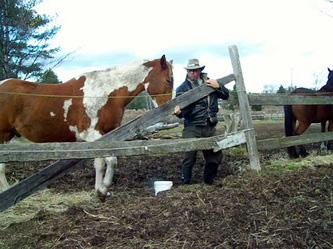
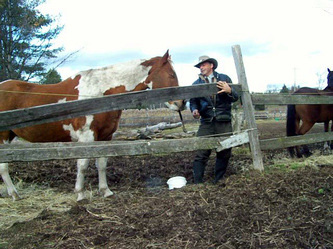
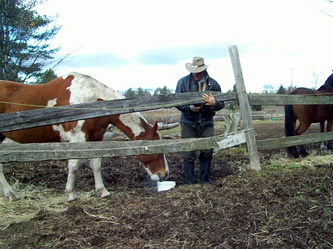
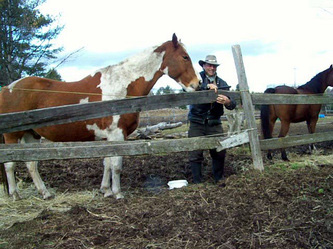
Don't know who took down almost a whole section of old fence (again) but lucky for a third 'hand' to pass the hammer
My main objective, and I tried to make this clear to people at the seminar, is that depending on what you want, you must be honest with yourself. In the end, whatever you end up doing, you should realize the choice you make and understand the difference.
If you really want to learn about your horse and be able to do things together and truly understand each other, don’t send him to a trainer. When you do not know what to do anymore despite all that you have researched, read, attended, viewed, do not send him to a trainer. Give up. Throw your arms down in ‘defeat’. Go out and face your horse and start with a clean slate; a big question mark. Think about what you want and think about what your horse wants. Work on that and see if you can make a friend. If that is what you really want, it may take a few weeks, six months, maybe a year. Sound crazy? If that is what you really want, how many years have you already spent or will spend doing all the things that give you what you don’t want?
References:
Michael Bevilacqua: Beyond the Dream Horse
Christine & Michel Denis-Huot Photography: Three cheetahs and impala
Institute of HeartMath: Science of the Heart: Exploring the Role of the Heart in Human Performance
Allan Watts: The Way of Zen
Discover Magazine: Prehistoric Culture: First to Ride
National Library of Australia: Scanning Electron Microscopy in Archaeology
Project Gutenberg: On Horsemanship by Xenophon
DreamWorks: How to Train Your Dragon
Mirror, Mirror On the Wall, Who's the Smartest of Them All?
by Michael Bevilacqua
October 2011
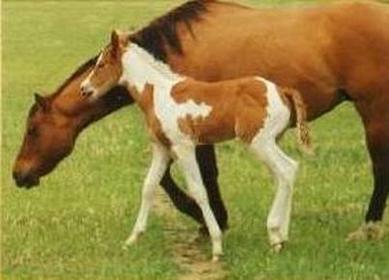
JR Big Leo - my 'little' boy is still learning and just as cute
Humankind has the habit of believing that everything around us is either for our personal use and compare or relate other forms of life to what we consider the only standard of perfection - ourselves. That comparison may not be a conscious choice, yet it is automatically made.
We tend to base intelligence of other species based on the comparative size of their brain to ours. This is also reflected toward our own ancestors although a complicated process of making an ocre paint, dating back 100,000 years, was discovered by Dr. Christopher Henshilwood, an archeologist at the University of Bergen in Norway and the University of Witswatersrand in South Africa. The typical standard regarding brains is that if it is not like ours in shape, size or perceived function, then there is no possibility of human-like intelligence. This view is erroneously projected onto our horses. Let us take an example of one of the lowliest life forms, the ant. They have no brain, as such, only mammals have a cerebral cortex. Compared to humans, they only have a handful of neurons. Ants have approximately 250,000 neurons that comprise the brain. In insects, these run along the length of the body and are called ganglions. Humans have approximately 11, 000,000,000 neurons.
Yet, ants can teach each other. There can be a teacher who can help a pupil find a food source. It is not just demonstration, such as “follow me”. The teacher will help correct direction, and slow down at times, at a cost to itself, to allow the pupil to integrate what he is learning, direction, landmarks. The pupil will signal to the teacher when he is ready to continue. The pupil, once having assimilated this information, can then become a teacher to another ant.

True teaching always involves feedback in both directions
In the April 2011 newsletter, The Missing Link, can be found other links about our brain. We are still discovering our own brain and have been surprised to learn that when an area that controls some specific function is damaged, we can re-teach or re-wire how our brain works to make something function again. We can, at least, trick the brain into believing that all is normal. An example of this is getting rid of phantom pain using a mirror box. Careful placement allows reflection of a good limb in place of a missing limb. A little exercise each day, synchronizing the two limbs allows the person to see movement of a limb that is not there and thereby decreases or eliminates pain caused by confusing neural messages that the brain picks up from nerve endings leading to the missing limb.
Our brain makes shortcuts all the time. We can see things appear as they are not, not see things that are right in front of us and ignore or block out what is in front of our very eyes due to our own beliefs.
You may have seen such an example through a video clip available online called the ‘Invisible Gorilla’. The task is to count how many times a ball is passed between people wearing white or black T-shirts. You are focused on counting the number of passes between those in white T-shirts and fail to see a gorilla, pounding his chest, walk right into the middle of the frame.
During the International Seminars over the recent years, I show a super-brief clip called the ‘McGurk Effect’. The results are a little more complicated. It involves that which our brain inherently knows in conflict to what is seen and what is supposedly heard. This disparity causes the sub-cortex of our brain to make a compromise between auditory and visual signals thereby producing and presenting to us something completely new. Everyone gets the same answer depending on whether they watch the clip or only listen to it. That is, there are two answers: one that is heard while watching the video and a different one that is heard when listening only. Even once you know the answer, it still happens all the time. There have been only a handful of people over the years, from all the workshops where this has been shown, who are highly intuitive and are not deceived by exterior stimuli and believe their ‘gut’ and get the true answer.
In ‘Beyond the Dream Horse’ I mention the book, ‘Blink: The Power of Thinking Without Thinking’ by Malcolm Gladwell. They are all tied in some way and make interesting viewing and reading to help understand ourselves.
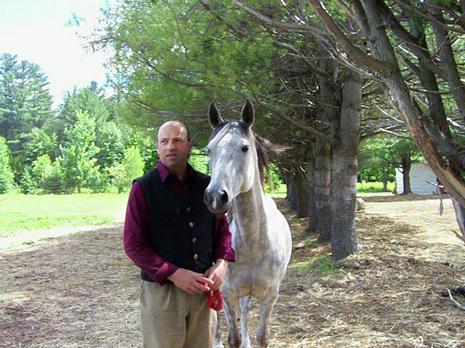
Relaxed but focused and in the moment even for distractions
Art, culture, advanced learning have all developed during periods of abundance. So it is with horses. When they are fully satiated they will play with that ball amongst themselves - the one that they totally ignored while you first tried. They did observe and learn, however. They will pick up that cone or a branch and have a tug of war between two horses. That is the best state, or time, for them to be in if you want to teach them anything. They need to be healthy, feel safe and with all their needs fulfilled.
The time of day is also important. Take notice of their up and down times. Go along with their rhythm to either incorporate play, focus/curiosity or relaxation. When they are restless or, for example, nearing an appointed time of day where they get some carrots and apples, that would not be the ideal hour to try to get focus to learn something new. When they have ate, played and then go into a sort of siesta or rest period, that is when I will do hoof trims. The otherwise most reluctant horse will be a perfect ‘gentleman’.
In my book I also mention how horses, in conventional training, are always expected to learn the words, walk, trot, canter, whoa. Why, then, is it commonly believed that horses cannot learn much more? If they do, it is often believed to simply be some kind of entertaining circus-like trick. People who have horses, either stabled somewhere but mostly those who have them at home, probably already know that we can share quite an extensive vocabulary. You can go further by making a lesson or class based on that.
If I go outside and see only four of the five horses, I will ask where is the missing horse. I say the name. The other horses, or at least one, will look in the direction of where the missing horse is located. This started by accident because I noticed it while I would be asking myself that question out loud. In our own little, created world at home with the dangerous, outside world only a fenceline away, I decided to elaborate on their learned knowledge, expand awareness and art of communication.
In my own experience from 2005, when I was suddenly immersed in the Russian language while helping to build the initial Nevzorov Haute Ecole forum, I learned a type of visual short-hand for language. For example, what I see as KRACC, (kлacc) I know that, to me, it means ‘forum’ in Russian. It really means ‘class’ but school or forum was the same thing at that time. It is not specifically the word itself, it is my identification of what that group of lettering means to me. Sometimes through exposure or focused necessity, I learned many more words this way and pieces of the alphabet. This continued without actually learning the actual language, however. Although I learned to understand the communication, or some of it, someone who did not know this would think that I could speak and read Russian. I decided to use the same visual learning with the horses. In a positive human sense, for a change, since I could do it, I never doubted that they could do it.
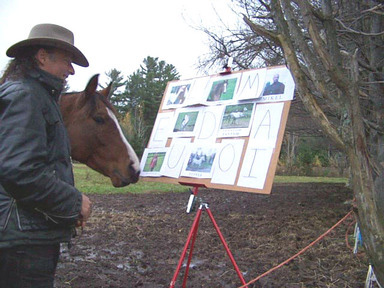
The image board
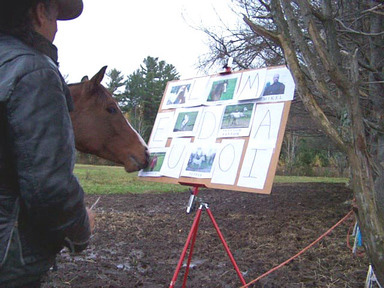
Primo pointing out a passer-by at that moment
I started with photos of the other horses with the name of the horse printed below the picture. Also, photos of the dog, the cat and different people that they know, including generic images depicting a man and a woman. If I notice something different when arriving at home, the horses could tell me if either someone we know or a stranger showed up while I was away.
They easily identified the photos of other horses, even people, by pointing them out (touching with the nose) when I gave a vocal name and indicated toward the board. This was without any practice. They already knew who’s who and what name they go by. This is no surprise just as they already know what ‘trot’ means or bucket or hoof or apple.
This learning is simple, fun, expanding, practical and on-going. With time, I tried removing the image of a horse but left the printed name. The ‘pupil’ would know the image was missing and point out the actual physical horse in the field. I gave the answer to the printed word, letting the horse know that I wanted it to be chosen specifically on the board. Now written names can be identified just as I was able to know what KRACC means.
I’m not trying to prove anything. This is not more than what people who have horses already know, to some degree or other. Maybe you just never thought of taking it a little further. It is just a more structured approach and may help to let you see your own horse in a different light.
I have become so comfortable with my life at home with horses. There are times that I am reminded that what I see as the color blue is not blue to everyone. I have become so accustomed to how the horses are that I take for granted their everyday expressions and actions. I only realise this when someone visiting will fall on his or her backside in awe after a horse does something that I consider perfectly normal within our little family. I also realize that my own experience has brought me what I was particularly looking for in horses. It was not a goal to find something specific, however, the results ultimately led to a way of life with them where I find a satisfying happiness. That experience is what I hold dear to my heart.
Some may think that trying to teach this to a horse requires this rudimentary form of visuals because horses are quite ‘simple’ as compared to human intelligence. I picked up on those visuals in Russian quickly and believed that the horses could do so in the same manner. Not because they have similar intelligence to humans but because the horses could simply do it. This is not to put on a show or because it is cute. I want them to stay as horses but this is to help the horses learn from me, ‘talk’ to me; for us to understand each other in a way that is generally considered impossible.
Along the lines of the famous quote by Mark Twain, Swiss pilot, Bertrand Piccard, is building a solar powered plane that he plans to fly around the globe by 2012 or 2013. The solar panels are along the top of its 64-metre (209-foot) wingspan.
After aircraft manufacturers said Piccard's specifications for that length of wing would be impossible, he turned to a racing yacht manufacturer to build the airframe.
"They did not know it's impossible, so they did it," he said.
From my own learning experience, I eventually did learn the distinction between ‘forum’ and ‘class’ regarding the word kлacc through familiarity with the letters within the word. Would it not be just great if our horses could learn the alphabet and spell things out? Coming to this point, where they know words, identify objects and groups of letters, why would we think that they cannot?
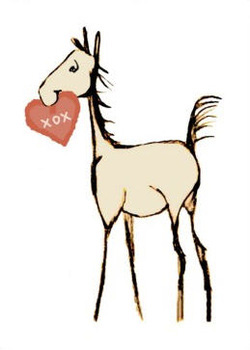
CBC.ca: Quirks and Quarks: Prehistoric Paint Box
Physorg.com: Teaching ants: First demonstration of 'teaching' in non-human animals
PainAction.com: Understanding Phantom Limb Pain
The Invisible Gorilla: Video test
University of California, Riverside: McGurk Effect
Malcolm Gladwell: Blink: The Art of Thinking Without Thinking
Bevilacqua, Michael (2010). Beyond the Dream Horse, Quebec, Canada: ISBN 10: 1453725261; ISBN 13: 9781453725269
Physorg.com: Solar Impulse: Swiss Pilots Aim to Circle World in Solar-Powered Plane
Hauteecole.ru: Manege Reading
Pushed to the Brink
by Michael Bevilacqua
September 2011
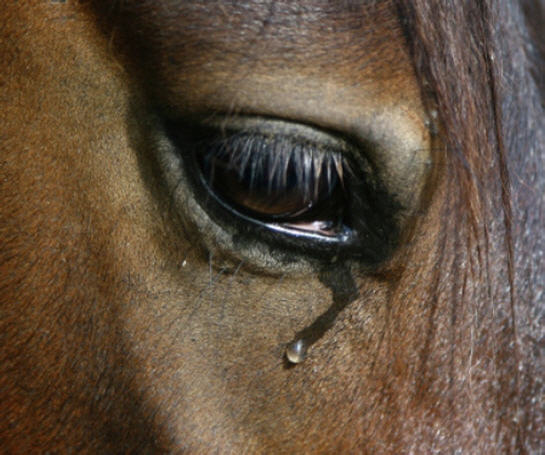
I was asked about the future of horses in an interview regarding the book last year and I knew, or know, that things will get worse for horses before they get better. It has already been well underway, at least here in Quebec, with the closing of major race tracks. The closing of those tracks was due to cutting of government funding. Breeders for the industry were left with overstock. They were the source of production for which there is no longer a viable market. It does not end just with business. The financial crunch for all people has seen more and more horses be torn away from their ‘families’. Sometimes, trying to give a horse away to a good home is almost impossible. Horse rescues and slaughter houses have been very busy lately.
Such slaughter stats have gone up in Canada but that should be no surprise since it has been outlawed in the United States. The growing activism for horses is notable, however, changing conditions for transport to slaughter or the abolition of slaughter does not address the source of the problem. It is not a matter of adding more laws to protect horses.The problem is that there has always been a double-standard in our own view toward other animals. Maybe I should write, our view of other species than our own, or other mammals. At the very least, we can say that we own domesticated horses, but the rules of law, or the term, does not apply in the same way as for a dog or a cat.
It is odd that it has been mentioned to me on occasion on how I interact with my horses is still unjust. While working at liberty, some say that the horses are not really free. True, I only have three acres, but more importantly, I know when a horse says no. It is obvious even in an enclosure that is 100x200 feet (30x61m). More obvious that they can be as free as can be when that enclosure has a 50 foot wide opening (15m).
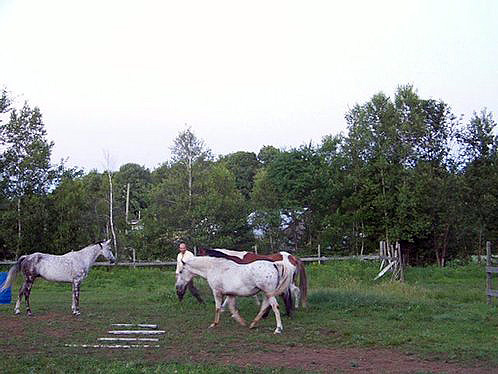
And while I stood there I saw more than I can tell, and I understood more than I saw
I do my best to live in the way that the world is. Fitting in but feeling like not belonging. I understand what people may be saying. It reminds me of a Lakota perspective from the book, Neither Wolf Nor Dog: On Forgotten Roads with an Indian Elder by Kent Nerburn. It mentions how the white man thinks that everyone lives as they do, or should, and all is fenced in or caged. In all our structure, boundaries and protection, we lose our own freedom.
Saying that we keep domesticated horses in a ‘herd’ is already a misconception. But, we know to what that refers. We try to keep our horses in a more natural environment and not in stable-like conditions. Free. Who is free? Horses are protected by a few caring souls because the world is dominated by humans. Horses cannot really be set ‘free’. All land has been divided into packets. No matter how big, there are boundaries and borders for all of us.
In my interaction with horses it is to keep them healthy, strong, and further develop their thinking abilities. I like to keep things interesting and fun for them. I could just provide a ‘prison’ and just throw hay over the fence but I want to learn more about them, personally, and likewise, them of me. I can befriend wild deer from the forest in the same way, but they are out there on their own to fend for themselves. They have come to learn that this is a safe place and come to visit. This is both at the same time beautiful and very hard for me. For, I often recognize some of those different deer, dead alongside the road, over the course of the winter.
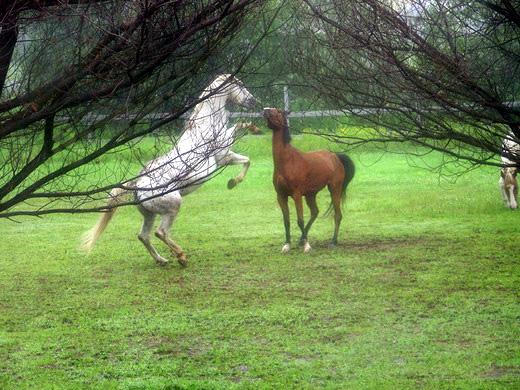
Elements of Nature Within Us All
I know of one place where horses are left alone and that is Sable Island. This thin strip of sand is 300km south-east of Nova Scotia, Canada. It is a 42km (26 miles) long crescent shape by 1km (0.6 miles) wide. There is no public travel to the island and the horses are protected by these restrictions as long as the Coast Guard maintains a station there. Whether protection is maintained or not, rising sea levels will claim most of the island. The horses are free to live and die all on their own. Population goes up and down according to the severity of seasons. Although they are portrayed as displaying typical, textbook herd behaviour, the horses on the small island share space and water and are generally more tolerant with each other in that sense. Mild winters permit the population to increase but many of the old, very young and weak horses do not survive the next harsh winter. Injuries are often not seen, not that it would make a difference, and horses can linger to suffer, starve and die even during warmer months.
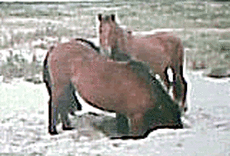
Horses digging for water in dry season - Sable Island
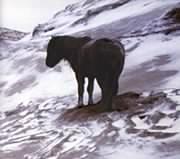
Surviving winter with scarce food - Sable Island
I invite you to take a look at the photography of the horses of Sable Island by Roberto Dutesco. A fashion photographer who learned to see horses in their true light and shares some incredible experiences. (See About Chasing Wild Horses in References below)
There is a distinction between caring for horses in our own created confines and keeping horses for our own needs or uses. In Beyond the Dream Horse I wrote about having observed different horses being put through grueling training for the ambitious or personal desires of people. However, the outcome of some unfortunate horses was mostly the same - horses would suffer injuries or be deemed not capable of achieving the desired physical form or end-use. The horse would be tearfully discarded only to be replaced with another who would have to endure a repetition of the exact same sequence of events.
Many people adhere to a particular method without knowing much else about anatomy, physiology, behavior, negative effects of bitting, horseshoes, riding or have a general disinterest in science. It is never my intention to demean or berate or lecture people. However, if asked and I were to point out that what a person is doing is based on negative reinforcement (applying an uncomfortable pressure or situation until the horse learns to respond accordingly) that term, ‘negative’, will insult or upset people. That is often due only to the word itself because many do not understand to what it relates. To be realistic and sypmathetic, most people do love their horses and want to believe that they are doing their best in achieving a true bond. Some may brood because they do notice something not right in the horse but block it out because of their strong idealogical wants.
We believe ourselves to be superior to other species but we have only worked long on developing our intelligence. We are so fragile physically and emotionally. Physical problems are evident and can be addressed but emotions are often suppressed. It is the hidden wounds that linger longer. It is no different with horses.
On the other hand, where I do believe that it is important to gain more knowledge about the horse, some people learn almost everything available about horses and training and healing. It is an on-going process of constant search and information flow that consumes them to the point where they lose the ability for plain, common sense. I give an example in my dvd set of people thinking, cross-referencing and second-guessing themselves for something so simple, that they stand frozen, unable to decide how to react with their horse.
I have seen a young child develop a better relationship with a horse than an educated adult. Horses may even offer a compromise or a solution to children when they figure out what a child may be trying to do or ask.
Information or Knowledge
I opened up last year’s International Seminar with a quote that left people somewhat puzzled: It is a Taoist axiom that intellectual scholarship and analytical logic can only serve to dissect and categorize information. Knowledge, different from information is achieved only through knowing. Ultimately, only intuitive understanding can provide wisdom. Truth, while elusive, exists. But, it is obscured by search because purposeful search will inevitably mislead the searcher from truth.
By the end of the seminar, despite ironically being flooded with information, they understood that axiom a little better.
Since awareness and education about horses have increased, there are not as many ‘revolving door’ horse rescues. We should realize that the reality of horses that are cast out and sent to a safe refuge are being cared for and have a better life than humans who are forced to go to refugee camps. When I had my old website, equiforme.net, I would get an offer to adopt a horse at least once a month. The reasons were always the same. It was rooted in a physical problem: the horse could no longer ‘keep up’ or just did not perform to win as expected for a variety of disciplines or even just local fairs! It is mainly the mentality and our view of horses that need to change. At times, I have been plainly faced with such old mentality and have suggested to some people that instead of buying horses, they should buy off-road vehicles or bicycles for family fun on the weekend.
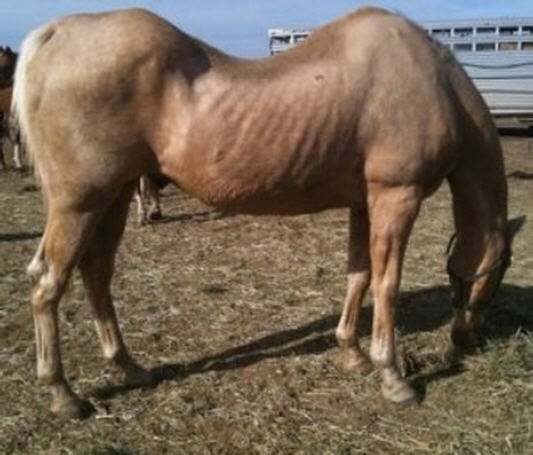
From an ad on Craigslist... 'he is well broke for any level of rider' but needs a new home
A lot in our world simply requires cash. In the past couple of years people have been forced to give up their horses due to financial strain, loss of jobs and foreclosures on homes. It’s a heartbreaking, man-made disaster. People and horses suffer both physically and emotionally. Rose Gergely, of Refuge RR, in Alexandria, Ontario, Canada, cares for horses and all kinds of other animals totalling over 400. She states that there has been an increase of horses being abused. Rose explains, “Now, is that because of publicity and we are hearing about it more or are people actuallly getting crueler? I think it is both. We have had nonstop calls for situations of cruelty from across Canada.” It is because of their main concern about the welfare of the horse that they can take in horses that other rescues will not touch. Refuge RR believes in giving horses a life beyond what they can do for humans. Some horses that have suffered serious neglect, trauma, or abuse find a permanent home at Refuge RR and are supported through sponsorship. Numbers are up everywhere. All are in need of food, labor and funding.
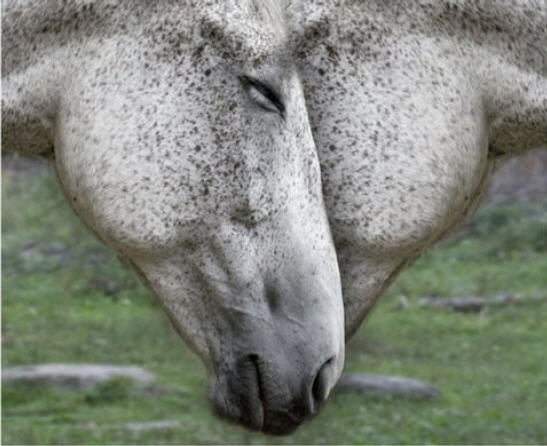
Photo taken by Metod Kolla at Refuge RR - www.refugerr.org
In cases of abuse or neglect, most people find such reports reprehensible. Having a horse or any other animal requires, at least, a certain level of responsibility. In the cases that we hear about, the perpetrators do not see anything wrong at all. They believe that they have every right and animals have no rights. Yet, most try try to hide what they do. Laws exist for neglect, assault, torture and murder in the human world. It does not stop people from doing those things to each other. The important changes must come from within ourselves, nurtured within the family and society. Those sad stories being more prominent in the news reflects a heightened awareness and the need for change. Such changes are happening around the world.
When I leave my little green corner and venture out, I feel like an alien in a strange world and very far from home. Yet, I am happier when I turn my focus to where I see that so much more is possible. It is not a utopic world that I long for somewhere, someday. Mystery and beauty is already unveiled in plain sight. It was the stillness of the forest and the horses that showed me the way.
I do not think the measure of a civilization
is how tall its buildings of concrete are,
But rather how well its people have learned to relate
to their environment and fellow man.
- Sun Bear of the Chippewa Tribe
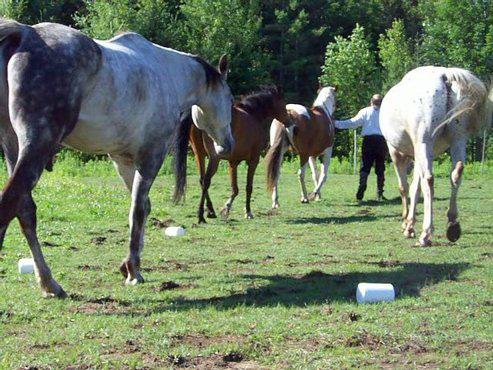
References:
Bevilacqua, Michael (2010). Beyond the Dream Horse, Quebec, Canada: ISBN 10: 1453725261; ISBN 13: 9781453725269
Sable Island: Virtual Museum Canada
DutescoArt: Photo Gallery - Sable Horses
About Chasing Wild Horses: Canadian Broadcasting Corporation - CBC
Dutesco documentary film clips: Chasing Wild Horses
Catherine Scott: Of Horses and Humanity
Henry C K Liu: Taoism and Modernity
Kent Nerburn: Neither Wolf nor Dog: On Forgotten Roads With an Indian Elder:New World Library; New edition edition (Sep 1 2002), ISBN-10: 1577312333, ISBN-13: 978-1577312338
Pearls of Wisdom: Native American Wisdom Quotes
Romantic Notions
And Rose-Colored Glasses
by Michael Bevilacqua
August 2011
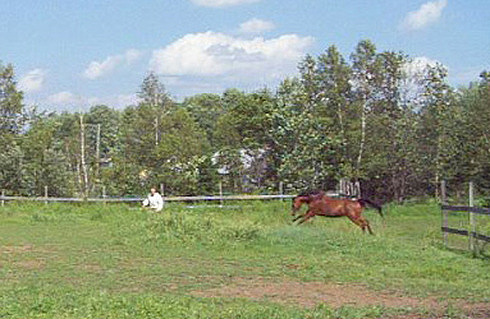
It still surprises me when I meet people seeking a better way with horses and looking for a better relationship with them. Not only for the fact that they are seeking a different way, but they are often well educated about horses, in health, nutrition, homeopathy and massage techniques. They try to give the best lifestyle for the horse as can be obtained in a domestic situation, and generally want the best for the horse. Yet, perhaps, as I experienced, many are stuck in some kind of norm of thought.
In many cases, such people are also vegetarian, or spiritual. They also have incredible relationships with dogs or birds and all kinds of other animals. I have had people tell me about the characters and moods of different animals in their lives. How they learned from each other, adapted to each other, learned likes and dislikes, to communicate fun, sadness, jealousy, curiosity, speech recognition and the simple processes of learning and growing together. In many cases, seeing this in action, I would directly ask the person why they called me for help. Why, after so many years of experience of relating to other species, did they not realise that they can simply do the same with horses? Why were horses inaccessibly beyond some imaginary curtain? It made many people think. Unfortunately, it did not really change the situation.
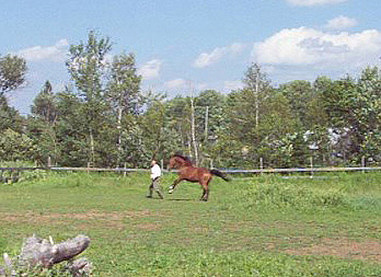
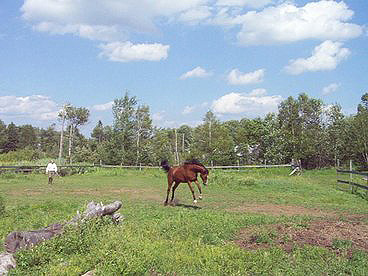
SPH El Primo age nine
Open Your Heart To Love
Notice how people react or interact with a young foal. If I had the power to take anyone’s horse and shrink him down to the size of a Chihuahua, the relationship would instantly change between horse and owner. Mainly due to the person’s new and different interaction with the super-mini horse and more quality time spent with him. A lot more time. He would be so cuddly, loveable, and cute. They would laugh, stroke, tease, and play with the tiny horse. Just like they do with dogs or cats or birds - but not with their real horse. Along with what we have been programmed to believe in the standard horse world, there is an aspect of fear involved.
Put a person face to face with an unknown, adult horse in a paddock and the entire dynamic, at least due to the human point of view, instantly changes. What causes that change, that restriction, that distance? Reasons can vary for everyone but one common factor would be our own conditioned expectations. That available innocence, joy and spontaneity are often discarded when looking at an adult horse.
Why would an adult horse have changed his perspective or attitude toward humans as compared to an exhuberant, playful, affectionate foal?
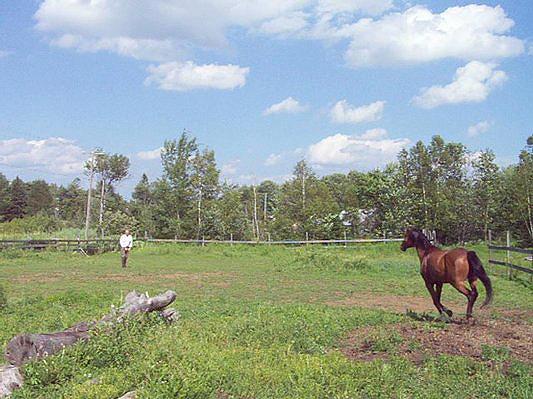
At any stage along the development of the relationship with the horse, through the various interactions that we initiate or allow to evolve, we must be conscious of doing only that with which we are comfortable. Likewise, if we are very certain and emotionally comfortable about a particular request we may have, it does not automatically mean that the horse is at the same level. It is by being self-aware and by adjusting to the horse that we can progress through various comfort zones.
Horses react to that which they are subjected. Once they become big, heavy and strong a simple move from them can unintentionally, seriously injure us. Yet, it is simply abuse if we hammer repeatedly any reaction out of, or into, a horse. If we teach a horse, and I do not mean `train`, but really teach with patience and clarity for understanding, view the horse with a positive, creative, loving and happy attitude, then the self-imposed wall crumbles.
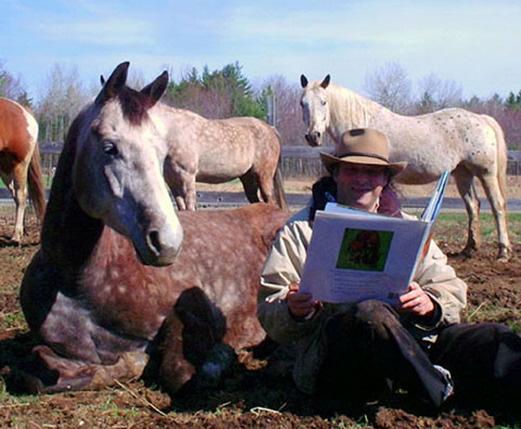
Enjoying the warm sun with The Big Book of Horses
Time spent with the horse should not be solely for trying to get something done. By treating the horse as a cherished companion, the barrier between human and horse ceases to exist. We will begin to see the gentleness, intelligence, and cooperation that were before us all along, but masked through proliferated notions that a horse is an animal that needs to be conquered and trained.
However, this is not always possible. There are very few circumstances or places in today’s world where horses play a necessary traditional, subservient role but they still exist. The best that can be achieved at this time is to educate people about the physical needs of work horses. One such organization is HSVMA (Human Society Veterinary Medical Association) which helps people in poorer rural areas at home and abroad. There are other organizations that send people abroad to educate. It is not to impose ideals or change but to improve the lives of the horses. It can be as basic as informing people of feeding and water requirements to hoof care.
In the journey with horses in our lives, many people come to realisations on their own and simply develop a shift in attitude toward the horse. This, also, does not always bode well. If someone has a change of heart or viewpoint but is making a living off the usage of horses there better be a well-established plan to be able to continue to survive and care for the horses. It is when the head and the heart go on divergent paths that problems arise. In my book I mention someone who had a bed & breakfast with horse rental. This person rented out horses to strangers on a steady basis to ride in the mountains at night. To continue to do that, there is no question about the possibility of giving the horse a choice, freedom of expression and removing controlling headgear. In the situation that they are in and the life that they live, those horses must be trained and do as they are told. At best, they can be well-cared for from a nutritional standpoint, shoeless and bitless.Time spent with the horse should not be solely for trying to get something done. By treating the horse as a cherished companion, the barrier between human and horse ceases to exist. We will begin to see the gentleness, intelligence, and cooperation that were before us all along, but masked through proliferated notions that a horse is an animal that needs to be conquered and trained.
However, this is not always possible. There are very few circumstances or places in today’s world where horses play a necessary traditional, subservient role but they still exist. The best that can be achieved at this time is to educate people about the physical needs of work horses. One such organization is HSVMA (Human Society Veterinary Medical Association) which helps people in poorer rural areas at home and abroad. There are other organizations that send people abroad to educate. It is not to impose ideals or change but to improve the lives of the horses. It can be as basic as informing people of feeding and water requirements to hoof care.
In the journey with horses in our lives, many people come to realisations on their own and simply develop a shift in attitude toward the horse. This, also, does not always bode well. If someone has a change of heart or viewpoint but is making a living off the usage of horses there better be a well-established plan to be able to continue to survive and care for the horses. It is when the head and the heart go on divergent paths that problems arise. In my book I mention someone who had a bed & breakfast with horse rental. This person rented out horses to strangers on a steady basis to ride in the mountains at night. To continue to do that, there is no question about the possibility of giving the horse a choice, freedom of expression and removing controlling headgear. In the situation that they are in and the life that they live, those horses must be trained and do as they are told. At best, they can be well-cared for from a nutritional standpoint, shoeless and bitless.
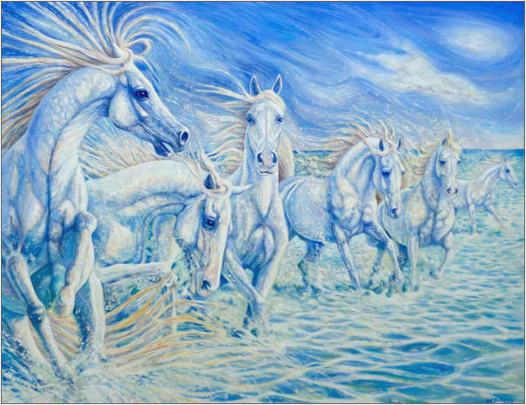
Painting courtesy of artist Gill Bustamente: Creation of Horse - fineartamerica.com
Removing the Veil
There are so many beautiful stories about the creation of the horse and how they were revered in so many different, ancient cultures around the world. The Arabian is highlighted for its strength of spirit and loyalty. One folklore makes mention of Mohammad who deprived his horses of water for three days. After releasing them to run toward an oasis, he sounded a battle call. Out of the hundreds of horses running to quench their burning thirst, only five mares responded and returned to him. Those five mares became the foundation bloodlines of the Arabian horse. Al Khamsa, meaning The Five. The Bedouins of Desert Arabia recognized their high intelligence and swaddled and cleaned a newborn foal as they would a baby. They protected the horse like a family member, believed in preserving their spirit and did not believe in harsh training methods. What would be considered harsh training methods back then? It is said that the native Arabian horses had no fear of man and could be easily approached and handled for they did not understand why anyone would hurt them. What is portrayed as a beautiful, divine gift, look what we have done to and with horses in history.
I have heard of a technique to bury a horse standing upright (head above ground) who would then be exposed to what is termed flooding. (The technique is very old but studying this and coining the term is only recent) This is more than sytematically presenting objects that a horse considers frightful. It is a barrage of all sorts of visual stimuli or noises and any imagined scary thing that could be presented to intentionally bring the horse way past the threshold of fear. The horse could not move; could not injure himself but also could not escape. When the horse would no longer respond to any stimuli, he was broke, or domesticated, or obedient, or rideable. Is that better than tying a horse to a post and slowly sacking out? Is it better than psychological dominance? Behavior modification or manipulation?
We no longer live with the horse on a daily, full-time basis to roam and survive together in a symbiotic relationship. It may seem like a romantic notion to some, but the reality was a harsh, nomadic life with constant dangers and threats to survival. Yet, we are still drawn to the horse and seek that mutual understanding and loyalty because part of the human spirit identifies with that of the horse.
If someone says that they have a cooperative, willing horse that will do whatever is asked at any time, it is most likely that what they have is a conditioned, trained horse. Even with no tack, it may be clear to onlookers that a horse may not seem very enthusiastic about standing still to be mounted. The worse case would be a result of learned helplessness in the horse to put on entertaining shows. Actually, that is total loss of will due to being subjected to repeated or prolonged painful or unpleasant circumstances. This holds true for people and animals as studied by the American psychologist, Martin E.P. Seligman, Ph.D. Learned helplessness is basically like giving up, throwing in the towel before even trying and even if the chance to escape is presented, it is not taken.
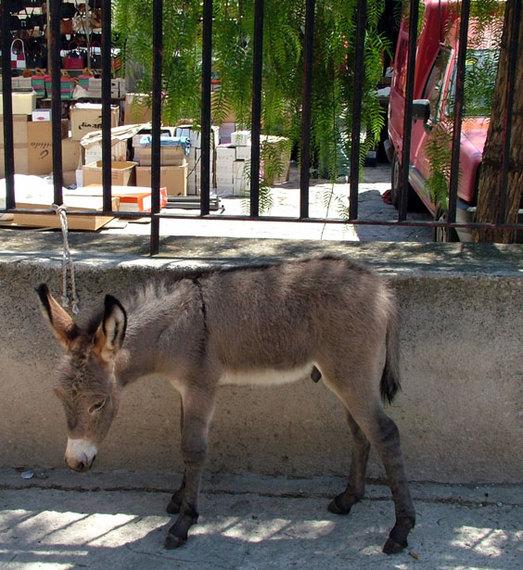
Pauvre poulain (poor foal) by Brunhilde Reinig
A simple, real-life example would be a woman who was jubilant to demonstrate how her horse would stand still in the alley with no restraints as she walks off to her locker to get a brush. I have seen a horse stand still, look at a feed bucket a few feet away, look back toward the woman, and just hang his head with a face filled with anxiety. He knew that if he moved, it would get very unpleasant. This also has physiological impacts such as stress and the ensuing results from prolonged stress; depression and diminished learning capability. The woman loved to show a very obedient horse, but I saw a very sad horse. Just like the word ‘respect’ mentioned in the previous newsletter, the term ‘willing’ is yet another word in the horse world that is interpreted in many different ways.
Beginning a New History
With all the different methods that have existed and do exist, consider that people are often looking for new ways to make the horse do the same things as always. Change, for humans, is not an easy process. We always tend to hang on to the old while slowly incorporating the new. It comes to a point where adding the new pieces to the old just does not make sense anymore. We are now at a point where there is a seemingly radical departure in horse-human relationships.
This different mentality toward horses, seeing things the way they are, is more commonly being applied as a result of our modern world, the long road we have done with horses throughout history and all that we have learned about them. We no longer need horses to facilitate our survival. We certainly do not need them for war.
It is not as simple as suddenly making a decision to change our apparent attitude. We can decide to change but only truly change when we come to some realisations. It is not so much that it is a work to build toward, but more important to let go of old thought and deal with feelings in a new way. It should be with love, or at least, honesty. It really turns almost all we have learned about training horses upside down. The horses never changed. They are just waiting, patiently, for people to meet them halfway. They never forget, but they can forgive. If freedom, respect, understanding and teaching is given to horses instead of trying to train them, they give us their all. What we do with that is another question.
Resources:
Positive Psychology Center, University of Pennsylvania: www.ppc.sas.upenn.edu/lh.htm
References:
Bevilacqua, Michael (2010). Beyond the Dream Horse, Quebec, Canada: ISBN 10: 1453725261; ISBN 13: 9781453725269
Seligman, M.E.P. (1975). Helplessness: On Depression, Development, and Death. San Francisco: W.H. Freeman. ISBN 0-7167-2328-X
Carissa Kelvens, California State University: Fear and Anxiety
Humane Society Veterinary Medical Association: ruralareavet.org
Kelsa Staffa, Fire in the Heart: The Al Khamsa Arabian: culturemagazine.ca
Al Khamsa: alkhamsa.org
Havemeyer Equine Behavior Lab, University of Pennsylvania: Unpredictable Fear
The Horse: theosophytrust.org
The Future is Now
An Informal Letter
by Michael Bevilacqua
July 2011
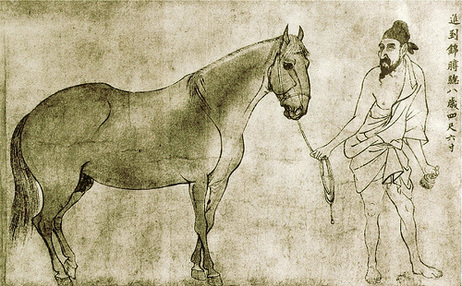
Li Gonglin (1049–1106) Chinese painter - Northern Song Dynasty
When I completed ‘Beyond the Dream Horse’ it was a condensed summary of so much information about horses, training, and our own shared search for answers. The story of my progressing realizations only reflects what is already out there or was known by someone, somewhere even before recorded history.
I think it rests on being a matter of time for us to be ready to embrace a certain existing viewpoint. As we get on in years, what we once read a long time ago suddenly has new meaning. Real meaning. Even if it is just a phrase remembered from childhood or a few paragraphs that were written centuries ago.
We have learned practically all there is to know about horses. We may have sometimes been misguided by some of our interpretations but the information is all out there perhaps to be only re-discovered.
I am not referring to traditional training methods but, of course, they still persist. If you were looking for a training method to bring you closer to your horse and, in a nutshell, I said that the best method is no method, that would not make much sense to you. When we want solutions with horses it seems odd that we often walk away from our horses to seek answers from people. It is still important because it can help shorten our journey with guidance, insights and cast clarity on what we may be searching for. However, sometimes it may seem as intangible as trying to explain love. With any animals that have any kind of social structure, if respect is given, then that is usually always reflected back. Such understanding is not only possible with any domesticated horse but perhaps more pronounced and appreciated with wild horses in their own habitat.
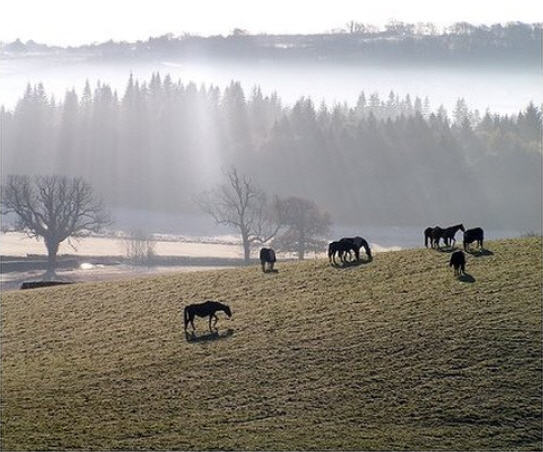
Photo by Dave & Lynne Slater - www.everystockphoto.com
That idea is simple and beautiful, yet, to someone immersed in horse training it may seem ludicrous. The long-held, standard belief is that horses must respect us. However, that notion has nothing to do with respect. It has to do with obedience and submission by the horse.
Over the Rainbow
There have been insights shared by many horse people but emotions are shared by all of us. There is a continuing unity forming, more or less along the same wavelength. I am not so sure that there are drastically alternative methods that exist anymore. They have become so common, wanted and accepted by so many people around the world. They have become more of a standard on their own. It only comes down to a matter of wanting to, or being able to, relate to the message.
As the previous example of the term ‘respect’, people are now quite discerning. A beautiful relationship or friendship with a horse has no place for any type of domination, physical or psychological. There is still a lot out there that caters to using horses for human ego or entertainment. Yet, the grey areas are fading and people are not fooled anymore by nice words or comparisons to semblances. However, the same message of real inter-species communication, understanding and cooperation can be presented differently. This is all good as long as it is for the benefit and real respect for the horse. Different teachers can express the same message but an ‘ah-ha’ moment that comes to the surface for one student may be missed by another. We can all help each other understand and grow. I have seen a seminar participant paraphrase something I said after a question from another. It was wonderful to see how that rephrasing helped someone else understand. How the message is conveyed in various forms is what makes the difference to many different people.
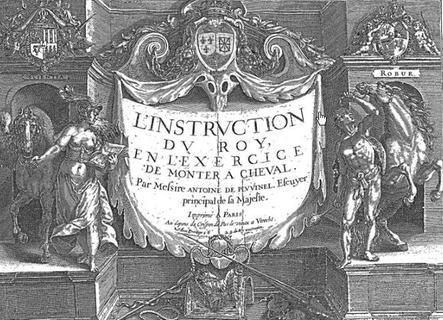
De Pluvinel - L'instruction du Roy en l'exercice de monter à cheval, 1629
In the introduction of my book, I mention the importance of following our instincts. If we want to so connect with horses, it is the primitive side that holds the allure and the simplicity. To realize this and not disconnect from part of what we are is not ‘savage’ but a pure part of the soul. It is part of the basic connection that we can share with horses and a part of us that can be just as noble. Appreciate and adjust to the moment and those moments will build upon each other. In a desire to co-exist or bond, you do not become part of the herd. See things as they are. You become a human accepted by the herd or even a single horse, in mutual respect. I think that is even greater than the common interpretation.
Hindsight is 20/20
I came to many conclusions on my own, thanks to horses. They were far from being brand new, ground-breaking revelations. If someone with similar experience explained it to me, way before that, would I have understood? At any given previous point in time would it have interested me? Would it have suited me with what I wanted from horses at that point? It would all depend on what I was looking for.
Sometimes, we must create or endure mountainous challenges to only later realize how simple things really are. Do not take what you have learned for granted. Accept what makes you feel good and do not worry about the rest. We cannot effectively force change upon ourselves or others. When people enjoy doing what they do, they do not like to be told not to do it. As an example from the book, it was when my plan of trail riding was taken away that I made changes thanks to my first horse. Adjusting to him by removing the bit and initially riding in just a halter allowed me to continue to do what I wanted to do. That small change from tradition, to the horror of many back then, was allowing and not prohibitive. The time for acceptance and change was right for me. Each time something like that happens, it puts us on the threshold of another discovery.
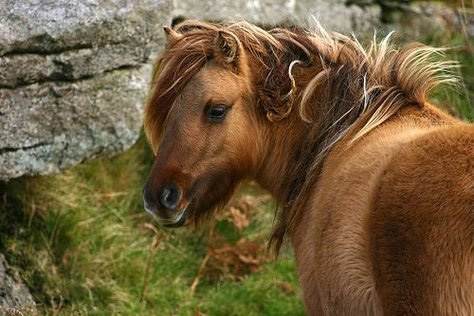
Photo by Kevin Walsh - www.everystockphoto.com
Understanding horses and nature are not common teachings that we all grow up with. In some cases, it is good that history repeats itself. Through time, something old becomes a wondrous new discovery to someone else.
I repeat myself all the time simply teaching what I have learned. I am realistic to what I am faced with. With all that still exists from the past, ignored in the present and continues to be perpetuated, sometimes it seems futile like going up against a brick wall. I often wonder if it is any use to continue. Sometimes the answers for love, respect and honesty seem so simple and basic that I wonder why I need to teach at all. Then, there are the times that I see a change deep within a horse’s eye or out of the blue a note from someone of heartfelt thanks. In the world that we live, this search, this path is not always easy but there are moments when it is very rewarding. When one has caught a glimpse of the beauty, how can you turn away from it? Despite all the answers that are all around us, within ourselves and in plain sight within our horses, we are drawn by a dot of brilliant, ancient light that continues to shine so brightly within our souls. So, in the grand scheme of things, as Gandhi once said, be the change that you want to see in the world.
- Michael Bevilacqua
A Changing World
by Michael Bevilacqua
June 2011
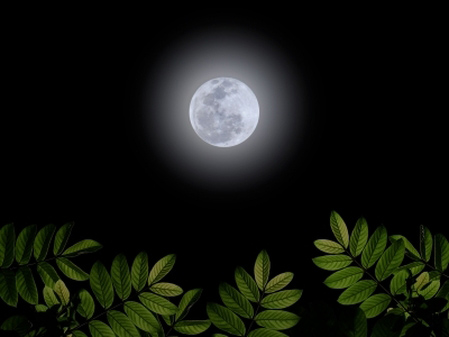
Exsodus - FreeDigitalPhotos.net
Global warming, the magnetic pole shift, increasingly erratic weather and natural disasters make us mindful of how to protect our horses and build contingency plans. There have been so many disastrous events around the world, we now know how close it can hit to home. According to the Annual Disaster Statistical review, there were 385 natural disasters worldwide in 2010 that killed more than 297,000 people. The surviving number of people affected was 217 million.
Not only are such disasters more common and widespread but occur with increasing or unheard of severity. The Earth is undergoing changes, as it always has, but in our tiny space in time of that process, we have to adjust to those changes to survive.
The earthquake in Haiti started off 2010 as one of the deadliest events in two decades. Out of 3.9 million victims, 222,570 were fatalities. The next highest was Russia with floods, wildfires and a heat wave between June and August contributing to a total of 55, 800 deaths.
Flooding and severe storms are a continuing problem worldwide on a scale never before seen. A dormant volcano coming to life is rare enough and geographically isolated, yet recent eruptions from different locations have had widespread effects.
A Shared Challenge
The numbers presented may help to make us take notice and we are beginning to realize that such events are no longer merely isolated, shocking news broadcasts in passing. We are collectively experiencing tragedy and loss around the globe to the point where countries are becoming focused on their own catastrophies instead of collectively helping others.
The first recent wake-up call was the tsunami formed from the earthquake in the Indian ocean near Sumatra in 2004. The effects and devastation covered the area from Africa to Thailand. Despite monitoring and warning mechanisms in place, we lag behind the animals’ awareness of impending danger. One of the noted events in recorded history is from 373 B.C. when many animals, including rodents left the Greek city of Helice just days before the devastating earthquake.
In the dismal human tragedy from the 2004 tsunami that struck Thailand, there were almost no animals among the dead. The ones that were easily noticed in trying to get away were elephants. Some broke their chains to head to the mountains, while others defied handlers while carrying tourists and moved to higher ground. Unexplained behaviour in animals is still often attributed to a ‘sixth sense’. It has been well-studied that elephants can communicate using infrasound. This is a very low frequency, below 20 Hz and outside the range of human hearing. Onlookers may think that an elephant is just standing still, but it has been scientifically proven that he may well be communicating over distances of over 40 kilometers (25 miles) thanks to sensitive nerve receptors in the feet.
The Equid family have a physiological structure that is not fully understood. It is called the auditory tube diverticulum or guttural pouch, located dorso-posteriously to the posterior pharynx. In 2003, Fauna Communications Research Institute concluded that horses do produce infrasound. Infrasound is outside of our normal perception, but it is produced by nature, including earthquakes and serves as a different means of communication available to some animals. Vibrational or electromagnetic, there are scientific explanations as to why many more humans died than animals.
There are common known signs that have been observed and learned from history such as catfish moving violently, chickens that stop laying eggs, bees that suddenly leave their hives, cats and dogs showing nervousness, restlesness, or inhabitual aggression. It is already known that horses, during a severe thunderstorm, will move to lower ground or gulleys if the choice is available. A good instinct to avoid wind, debris and especially, lightning.
For those of us who are aware of disasters close by, there still exist silent dangers to us all, and to our horses. One of these is ultraviolet radiation. Van B. Nakagawara, O.D., of the American Optometric Association explains that UV radiation is composed of invisible high energy rays from the sun that are recorded beyond the violet/blue end of the visible spectrum. UV-B in particular is damaging to the crystalline lens of the eye and can cause ocular disorders, cataracts, cancer of the skin around the eye, photokeratitis, and corneal degenerative changes. UV-A can damage the retina.

Polar ozone-destroying stratospheric clouds - www.nationalgeographic.com
The ozone layer located in the stratosphere, which is 20 km (12 miles) above the Earth prevents most of the UV rays from reaching the surface. Although an expanding ozone hole has been monitored for years in the antarctic, in 2011 the first ozone hole is developing over the Arctic at a quicker rate due to high-altitude freezing. The degree of ozone loss was larger this winter than ever before. Markus Rex, a physicist for the Alfred Wegener Institute for Polar and Marine Research in Bremerhaven, Germany, announced concern about this ozone depleted air reaching as far as northern Italy in Europe or New York or San Francisco in the United States. This can occur until late spring and affect different areas as the air mass moves southward.
Protect yourself by covering up or using sunscreen, wear UV glasses and provide outdoor shelter for horses during the day, especially between 10:00 and 15:00 hrs. (10am - 3pm). As the years go by, this situation will worsen.
Forewarned, Forearmed; To Be Prepared is Half the Victory
- Miguel de Cervantes Saavedra, Spanish writer and author of Don Quixote (1547-1616)
Severe storms are causing forest fires, flooding and landslides. Sometimes the storm itself can pose the greatest threat. Such situations usually require evacuation. You should identify what type of potential problems exist in your area and make a plan. In a severe or widespread disaster do not expect to call 911 and be instantly rescued. Everyone is affected when a crisis strikes, so talk to neighbours in your community or set up a meeting to discuss available resources such as types of shelters or relocation areas for horses, who has power generators and if they are mobile, types of vehicles or trailers to move horses, hay and water. Establish a contact network and a plan of action. Discuss various scenarios, different options and routes to be used. Review area maps and know where you would go if roads are unusable. If a set plan turns out to be not executable due to some other unforeseen event and everyone has to get away, then at least you can watch each other’s backs.
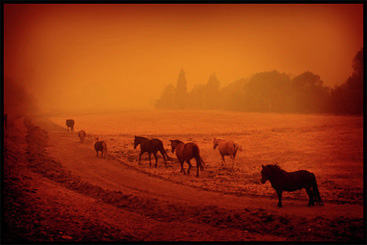
Photo - EquiVetAustralia.com
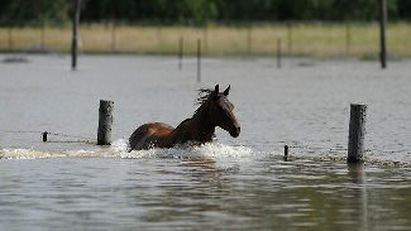
Photo - EquiVetAustralia.com
You must decide whether to stay or go. Take into account the number of horses you have and the time it would take to evacuate. There is a big difference if you have one horse with a one-horse trailer or forty horses. Depending on the situation, it is better to be safe than sorry.
Maintain at least a three day supply of food and water for you and your horse(s). You may not be directly affected and are able to stay, but an event could happen nearby that cuts off roads, electricity and either disrupts or contaminates drinking water. Allow at least twelve liters (12.68 quarts) of water per horse, per day. Keep chlorine bleach on hand to purify water: two drops per litre (or quart) of water and let stand thirty minutes.
If you have to go, have pictures of each of your horses on both sides, preferably with you also in the picture to identify yourself as the owner. You can put copies into a ziplock bag with any pertinent papers, instructions, your contact info and wrap it around the halter with duct tape. A contact number can be written in permanent ink onto the halter. Never use nylon halters, they must be breakable in the event that a horse is lost and gets snagged on debris. An ID can also be etched into the hoof and/or a waterproof tag braided into the mane or tail. With advance warning you could use small animal clippers to ‘etch’ your name, number or ID onto the horse’s neck or write directly onto the horse with an auction crayon. At worse, use spray paint!
Keep a first aid kit to be able to clean, disinfect and bandage wounds. Keep required medication or tranquilizers, if you deem it necessary. Talk to your vet and learn what is available and what you are allowed to administer.
Find Peace of Mind and Courage in Alternatives
In Quebec, there are frequent little tremors but this past winter, one was prolonged and grew in intensity. It scared me enough to get into the field. Seeing that the horses continued to calmly graze, reassured me. Outside was definitely the safer place for them, too. It was a frightening few seconds and I never felt so helpless. It was that event that motivated me to get informed and prepare an emergency plan.
Increasingly frequent weather fronts producing high winds often cause power outages here. Access to water is my priority. A gas generator is useful to run the well pump but is limited to how much fuel is available. By talking to local farmers about my concern, one looked through his old barn and gave me a good, old-fashioned hand pump - the kind with the long handle that you raise up and down to get the water flowing.
The references listed not only helped with this article, but I strongly suggest looking at the spca.bc.ca link. The EquiSearch link contains further links and resources. Also, the Wildfire Preparedeness link has a checklist that can be useful in any evacuation situation.
After the recent flooding in Australia, you may have seen the video that went viral in horse circles, but also made the news broadcasts. Water levels were so high in some areas, that only the roofs of houses were still visible and the video was of a swimming horse trying to unsuccessfully get onto the roof of a house.
You are responsible for your horses. Letting them go to fend for themselves should only be an option when a disaster strikes with no warning. A little research, preparedness, and local networking can protect you and your horses. In the event that you become seperated, the small actions you take beforehand will have you reunited. May you all be safe.
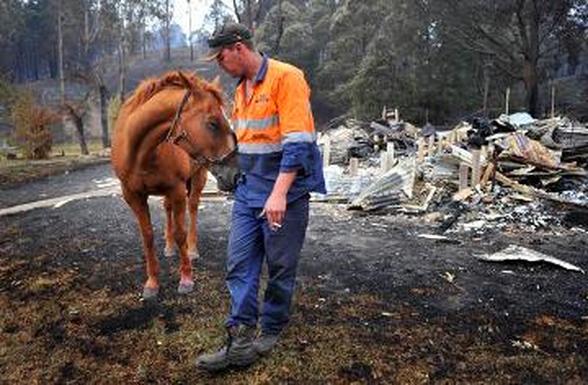
photo - equivetaustralia.com
References:
American Optometric Association - Utraviolet Radiation in Aviation
National Geographic - First North Pole Ozone Hole Forming?
National Geographic - Can Animals Sense Earthquakes?
National Geographic - The Deadliest Tsunami in History?
Canadian Broadcasting Corporation - Disaster Report
EquiSearch.com - Create a Horse Disaster Plan
SPCA B.C. - Disaster Preparedness - Horses
EquiVet Australia - Natural Disasters - How You Can Help Your Horse to Survive
Life Science Foundation - Can Animals Predict Disaster?
David J. Brown - Animal Earthquake Project
PetQuake - The Official PETSAAF Database
Fauna Communications Research Institute - Horse Communication and Infrasound
PBS.org - Can Animals Predict Disaster?
Colorado State University - Wildfire Preparedness for Horse Owners
The Fragile Leaf
by Michael Bevilacqua
May 2011
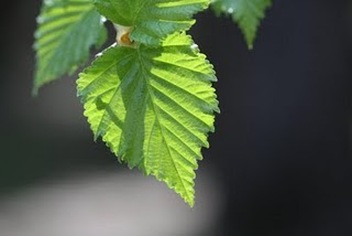
Photo by Catherine Scott
In the past month a similar question has been asked to me three times. The question is whether my life with horses has changed the overall perception of life and other people.
That recurring question shows how we share so much in common and yet often think that we are hiding personal thoughts or notions. The same thoughts that are felt by so many. Spending so much time with horses and seeing their own character allowed me to choose to respect that individuality. It caused me to listen closer. With the recognition and acceptance of what a horse can convey to us, it helped me to increasingly adjust to the moment. It did change how I view life and people. It helped slow things down for me which allowed me to see and experience and appreciate a lot more.
Being with a horse, reading off each other and learning the subtelties of expression permits us to become like an intimate couple who can instantly read so much information, or at least get a clear message, with a mere, quick glance.
It can help us to accept the way things are and to relate with another in any given situation. Aside from joy or satisfaction, we are often so disappointed, frustrated, or even angry due to adherence to our own expectations. This is where appreciation should come in instead. We tend to have expectations from others and it could often result in judgement, animosity or resentfulness or lingering bitterness. Whereas we can share with one another, we do each have our own lives and purpose. Yet, we are all connected and even if a specific situation or person disappoints us, or rather, does not meet our intended expectations, the situation may have created an important event or benefit for someone else. It may unexpectedly present something new to us. It may also cause us to be strong and stand on our own or make new connections with others to force self-growth or achieve a particular goal.
Best of Both Worlds
With horses or people, being demanding, and/or critical will not make you many friends. To reach altruistic levels or higher spirituality or understanding we must embrace our humanity. However, high-minded thought and reality are often seperated. That is what I meant when I wrote a section in the book, ‘Beyond the Dream Horse’, about our spiritual and biological sides being interfaced. It starts with our own inner peace and that can also be achieved through activity outside of ourselves. Many seperate the two with high ideals, but outside of a cozy, peaceful meditation room (or bubble bath or any quiet spot), daily reality can stir the 'animal' in us. Especially a time of crisis can create a feeling of helplessness or anxiety or fear and we often need or demand immediate results or answers. There is often a sense of desperation to fix something that we feel has changed or has been lost.
Adjusting to the moment, can only prove to be beneficial. If we allow ourselves to take a step back and view what we must do, time will inevitably take its course and lead us to a desired resolution. Thus, avoiding passionate, hasty, radical, foolish or even dangerous decisions that would certainly affect our future and possibly eradicate the possibility of any desired outcome.
We can all learn something from each other. Awareness and an attempt to understand another does not have to lead to lifelong, intimate friendship. It could be as simple as how you react to, or treat, a new cashier after you have been standing in the checkout line for twenty minutes.
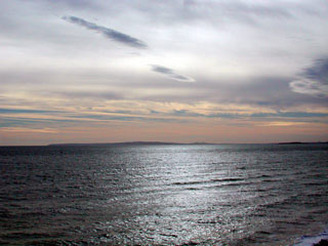
Blending above and below - photo courtesy of edenpics.com
The Shared Experience of Our Hearts
Over the years there have been a few people who have convinced me to give private instruction. In conversation, they demonstrated such in-depth comprehension and needed only guidance or reassurance or a little more clarity or insight to build a relationship with their horses. Sometimes I would be uncertain due to observed disassociation between the words and the actions of the person. I have, nevertheless, acquiesced when some would practically beg me for private classes and then they abandon the path with the horse.
I have come to realize that I should not be disappointed. Perhaps that experience was only a stepping stone in their own lives. Instead of feeling that I wasted my time, I am happy that they have moved on having overcome some obstacle within themselves or their lives.
I realize, that for them, it was an opportunity at an inopportune time. It was not wasted and it was not for me to judge after agreeing to give of myself. For, years later and thousands of miles apart, some established the life they wanted, including horses, and thanked me. For others, I realize that something, somewhere motivated them to make a connection to some aspect of life with horses. They did grow, they did learn but it was about a personal issue to which I may be totally unaware and had nothing to do with horses to begin with.
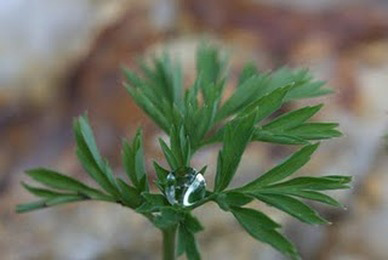
Good ingredients can form but only blend at the right time - photo by Catherine Scott
The way of being embodies many of the traits of what Native Americans call Deer Medicine. It includes a respectful connection to nature; to not be pushy to others to change; no ulterior motives or hidden agenda, appreciation of the beauty in balance for strength in unconditional love and compassion; to touch the hearts and minds of wounded beings, to know what must be done and overcome obstacles, among others.
To share with you an answer to a related question about my favorite Zen Koan, “The Stingy Artist” would aptly reflect such an openness or non-judgemental acceptance to the world around me. Avoiding, most of all, assumptions. As Ashida Kim explains on his website these koans, or parables, were translated into English from a book called the Shaseki-shu (Collection of Stone and Sand), written late in the thirteenth century by the Japanese Zen teacher Muju. There you can find a straightforward list of koans.
All good traits to which to aspire. In any case, I am no Zen master. That is why I focus on doing things with horses and hopefully, through action, allow that beautiful, innate awareness and potential to unfold within people and to recognize and appreciate it within our horses.
References:
Ashida Kim - Zen Koans
Beyond the Dream Horse - www.beyondthedreamhorse.ca
Deer Medicine - birdclan.org
The Missing Link
by Michael Bevilacqua
April 2011
That title may be a familiar term in a theory of human evolution but this topic deals not only with a physical step but with our inner evolution as well. Most of all it is about our journey with horses.
Everything touches, in some way, everything else. Life is movement, growth and change. In building a relationship with a horse or being able to advance while doing things with horses, sometimes apparent non-activity could prove to be just as crucial. If someone explained to me that they were trying to build a better relationship with their horse by sitting in a pasture, I would try to explain that sitting in a pasture is not enough. Weeks and months could go by and all that would have been attained, in terms of relationship, is familiarity. A routine of a person sitting in a chair or under a tree and wind-blown tumbleweed going by would be just about the same for a horse. If you are with an old friend who knows you inside-out, hanging out is not the same thing because the relationship is already there. However, this action alone, of being outside with a horse, or rather non-action, could be very beneficial for you in a different way. It can actually lead to inner developments which will not only serve what you want in the long run, but partially create it all on its own.
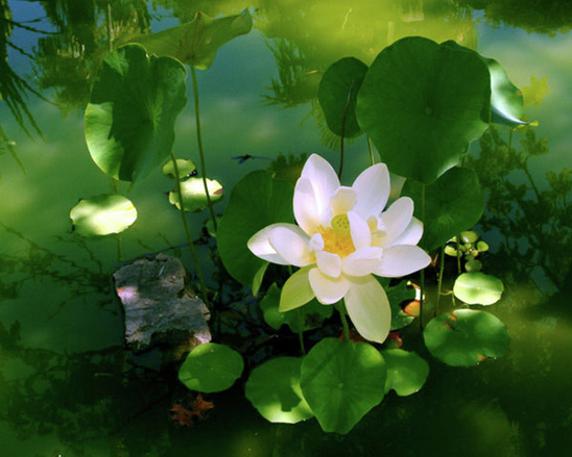
Photo courtesy of Edenpics-com - Sacred Water lily also called Blue Lotus, Indian Lotus or Bean of India
An Inner Longing
Important scientific evidence shown in different studies from japan reveal that exposure to nature dramatically improves physiological and psychological responses. It also significantly reduces the negative effects that are created by the body in an urban environment. Japanese shinrinyoku, meaning taking in the forest atmosphere or forest bathing, has produced rather astonsishing results shown by blood samples and measuring levels of cortisol in saliva, effects on the immune system, brain activity, pulse and blood pressure. There was also a fifty percent increase of the immune system's natural killer cells and anti-cancer proteins.
There is an increasing tendency by people to seek something more from our daily routine as it predominantly exists. Spending time with horses raises even more questions. From way back, a common term was ‘horses are our mirror’. The importance of that phrase is how horses can help us reflect upon ourselves due to our actions. Passion for horses can lead us to extensive study that seems never-ending but while we may know the structure of a hoof, we may not know how many bones are in our own hand. If you want to be able to help others, you have to take care of yourself first. Otherwise, you will not be able to help any one at all.
Once, while giving a private workshop for a family, the teens mentioned that they had seen the movie, ‘Avatar’. They were amazed at the beauty of the environment found on the fictional planet named Pandora. When they left the theatre they, and many other movie-goers, turned around and went back in to see the film again. This movie created an unexpected reaction from the public. There were many cases of depression after seeing the film. I suppose it could be described more as a longing for such beauty that is lacking in our ‘civilized’ world. This should come as no surprise because, although most of us do not realize it, the reasons for those feelings also go way back.
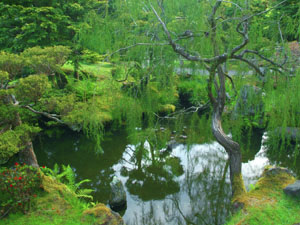
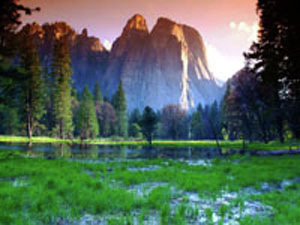
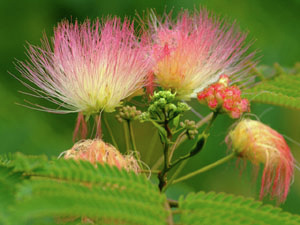
Photos edenpics.com
The Beauty of All That We Are
A study at Rutgers University of New Jersey discovered that simply viewing flowers had a substantial effect on people by producing pleasant emotions, a positive outlook, satisfaction in life and improved social behaviour. Add to that, wide open spaces and the sound of running water and we start to feel a sort of inner peace thanks to our primitive limbic brain stem. That may sound like taking away some of the joy and beauty of it, but it is all connected.
In ‘Beyond the Dream Horse’, I mentioned how our ‘spiritual’ side, or mind or our inner limitless imagination and depth of possible reflection, is fused or interfaced with our biological bodies. The mind changes the brain and the brain can change the mind. It is our consciousness that seems to define who we are and the body serves as our very own avatar.
If I take a step back, I always believed that we, humanity, are all students and the Earth is our school. However, the steady expansion and complexity of man-made civilization has further separated us from nature. In our world of processed foods, technology, landscapes of concrete and steel framed towers, we have long lost a vital life-nourishing connection to part of what we are.
Merely the fragrance of a bush of blossoming Hawthorn flowers will open up your arteries. This will help your blood flow to better nourish vital organs and the brain. It provides a boost of vitality, well-being and concentration.
While multi-tasking in a work cubicle or sitting on a freeway stuck in traffic, the brain emits beta waves. Beta waves help us in our daily activities and to think logically but too much beta can overcharge our system by increasing blood pressure, causing anxiety, panic, and make us think a lot about not much at all.
In a walk along a garden path, the brain would automatically switch to emitting alpha waves. A lot of good is said about alpha waves, but as we are interconnected to all around us, so is all not so clearly separated within us. It is usually never either/or. The commonly referred alpha waves or more correctly, alpha-theta waves allow greater concentration, creativity, heightened intuition and awareness. It is similar to the first stage of meditation, permits relaxation and introspection. All this and it requires no effort on our part.
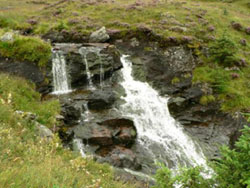
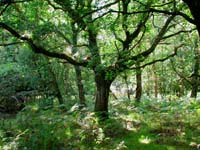
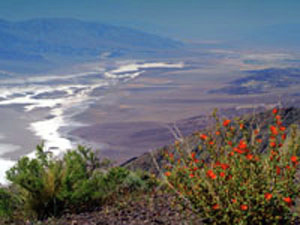
Is it possible that in our belief of being superior, repressing and disconnecting from nature could be a major cause of rampant behavioural problems in society? On a physical level, seventy-five percent of all illnesses reported to doctors are the result of stress-related factors.
Believe In Yourself
In our search for answers, what we usually end up seeking is someone who will hand them to us. The world around us quietly provides so many answers if we would only listen with our eyes and see with our hearts.
Horses may be considered as prey but it is their directness that makes us step back and question ourselves. Some believe that horses are connected to a higher spiritual or cosmic power. It does not matter if it is a transcendental belief, religion or what the Chinese call Chi. They are certainly connected to the earth and know what is good for them or to seek out what the earth provides to heal themselves. Let us not forget that we also share those same connections. This makes us, both at once, the teacher and the student to ourselves. Another common phrase is ‘the horse is my teacher’, but horses only indirectly allow us to draw forth the answers from within. Such is the true meaning of education.
Changes can take place if you begin to notice the good things that happen around you and in yourself; acknowledging any markers of success or noticing people who show some kindness. Reflect on the positiveness and imagine it being absorbed into you. The natural activity of neuroscience will build your brain, change your mind, change the perception of your daily life and your relationship with horses and people. The Buddhist monk, Mathieu Ricard, said that if you take care of the minutes, the hours, days and years will take care of themselves.
References:
Current: Excerpts of Interview with David Suzuki: Current.com
Limbic System: The Center of Emotions: healing-arts.org
Rutgers Evolutionary Psychology: The Emotional Impact of Flowers Study: aboutflowers.com
Forest Bathing: enhances human natural killer activity and expression of anti-cancer proteins: PubMed
Shinrin yoku: Case Studies: Milestone Activities
Buddha’s Brain: The New Neuroscience and the Path of Awakening: wisebrain.org
The Brain From Top To Bottom: McGill University
The Quest for the Emotional Brain: McGill University
Brainwaves: causeof.org
Mismatched Socks
by Michael Bevilacqua
Feb 2011
To view this article with pictures go to the main article
Since Nevzorov Haute Ecole (NHE) is mentioned in the book as part of my experience, it has also raised a lot of questions. NHE was created by Alexander Nevzorov and his wife, Lydia Nevzorova. Their research has raised the horse to a new level achieved without force, bits, spurs, whips. This article is to help clarify some misconceptions about NHE and I do so from the experience along with Lydia and Alexander's journey from 2004. It also addresses common questions or problems that I saw surface or heard about from the NHE forum/school.
There have been a lot of comments or questions about what to do with the horse. That may sound strange but a large part of the reason for such concerns has been since Alexander Nevzorov no longer advocates riding. From earlier articles or from within the forum you may have heard the question, ‘Were horses created for riding?’. The answer to that question is 99% No. Of course, that direct question aside, it also follows that people really think, ‘What else is a horse for?’ This part of the article is not an argument about riding or not but about the results of the reflection from people resulting from that question. Believe it or not, knowing that horses should not be ridden has been known for a long time. Present-day articles from vets mention it, but then, since we ride anyway, they go on to describe the best saddle fit or we hear of massage techniques or pharmaceuticals to get rid of the symptoms of underlying problems that we cause in the first place. That is the simple reality that people cannot bear to hear or believe.
Being passionate about Haute Ecole (most elaborate and specialized form of dressage) it was Alexander's initial objective to be able to ride but without all the painful, controlling gear. Although he achieved it, believing that natural collection was powerful enough to protect the horse from damage changed. Every step along the way brought a new question which led to further adjustments in his thinking to reduce riding time. Ultimately, riding had to cease altogether. Sitting on a fit horse, even in natural collection, will inevitably still cause ischemia. This is the first and only one of the problems caused by long-term riding. It is when the blood supply to the tissues in the saddle area is compromised, leading to tissue damage and tissue death. An excellent fitting saddle could give a subcutaneous pressure of 1.93 psi. This well exceeds the highest pressure found in the arterial capillary bed of 0.75 psi. A simple example is pressing on your skin and the spot turns white (no blood flow) or crossing your legs and one 'falls asleep' or goes numb. Alexander is not the first person to mention it, but he is the first person that I know who actually publicly stands by the horses he loves.
At the beginning, pursuing Haute Ecole was not something that I had considered but the exercises became more fun as the horses progressed. It was also a very good way to enhance the relationship and comprehension between us. They built strength, would consciously go into natural collection and doing so more often at play. As Xenophon once said, "A horse is such a thing of beauty; None will tire of looking at him as long as he displays himself in his splendor."
A turning point for the worse in the popularity of NHE was due to a statement from Alexander in the School Tractate series. He explained his view that horses should not be kept in a herd because they become stupid. Actually the real problem is that he did not fully explain that statement. People reeled in shock. Despite what people had learned about NHE, what attracted them, how they saw and read so much about what we do with horses, that one sentence changed their entire outlook of NHE.
Not many stopped to think, “That doesn't make sense coming from Alexander. What does he mean by that?”.
It led to an exodus of forum members and, even some representatives, who believed that Alexander isolated his horses and kept them no better than stabled sport horses. The crudeness or vagueness of that sentence, with little explanation about what he meant by ‘herd’ or ‘stupid’ certainly had many among the barefoot crowd in an uproar. It was just at the time that a more natural lifestyle for the horse was taking hold; many people were learning to hoof trim their own horses and horses being outdoors with freedom of movement was becoming mainstream. He is not talking about a group of domesticated horses in your backyard. He means a real herd. In a wild herd horses will draw upon other intelligence for survival alone. It is going back to instinct without any other learning or care in a domesticated environment from any human.
Lydia in 2008 after Praefatio became public:
"There is not strict rule how to keep horses in the school!!!!!! Our horses are outside 24/7 (rugs are for Russian climate where horses of our breeds should not live). Small groups are very good!!!!! and its not a herd! Food should be available permanently. Care for injuries and cold, hoof trimming and care about insects etc. Everything for horses comfort should be done, so horses can devote most of its time to study and developing, not for searching food and trembling due to cold."
It was too late. Even today someone asking me for help about changing the way of being with horses to create an understanding relationship may raise a question about Alexander's statement because they picked it up from another forum. Something along the lines of, "Oh, glad to hear that you don't isolate your horses anymore". Never did. Never will. This is all about respect for the horse, health, living conditions, freedom of movement, food, water, attention and constant care. It also depends on circumstances, space available and how your horses get along. Thankfully, I have not heard from anyone or about anyone who literally adhered to the propagation of that misinterpretation about keeping every horse separated.
The desires of people about what they wanted from NHE varied. This continued as NHE evolved. The now defunct forum was also considered a school. What a lot of people do not realize is that it was Alexander's personal journey of discovery and he took us along with him. We were there when he came to some understandings and then realizations that he had to change some recent belief. It was evolving with his analytical view, empathy and later to scientific proof relating to detrimental previous standards of horse use.
Alexander explained in his book, The Horse Crucified and Risen, that working alone with a horse, with no distractions, is what he found to be the most effective and quickest way to developing any physical or intellectual aspect of the horse. He said that even being outside alone with a horse was not perfect because of distractions from anything outside such as a fly on the horse's belly. Lydia also explained that this was Alexander's personal experience and is not a rule.
Alexander worked with one horse at a time in the manege often with only the sound of a metronome for focus on timing (despite the pigeons).
Many people do not have a quiet manege to work in but many people around the world still succeeded with their horses with only a field to stand in. Alexander joyfully recognized these achievements and gave personal guidance.
From conversations that I have had with different people, it becomes evident, in many cases, they were not too interested in pursuing the Haute Ecole elements. They were interested in relationship or developing the mind of the horse. They loved the NHE philosophy and wanted to improve their relationship with their horse and develop understanding, communication, strength, flexibility, trust, thinking, expression of character and play. It also becomes clear that most people considered all of those things not for the welfare of the horse, but only as a stepping stone to get what they really wanted – to ride a willing horse – or to enjoy riding without ‘arguing’ with the horse. If riding is not in the picture, many people have lost interest in doing any of the exercises. The main motivation was really for themselves, not for the horse. Sadly, now a common phrase heard is that horses end up doing nothing at all and getting fat. It does not need to be so, at all.
People often look only for a way to make their 'animal' do something for them. That is already off track. What most people do not understand is that NHE is not about a training method. It raises the horse to an entirely new level for recognition of cognitive abilities and even though horses do not communicate like we do they can certainly learn and understand. Any of these exercises are not required by NHE. They are all to show what is possible. Alexander would achieve it, prove it, and move on. That is a point that Alexander wanted to get across to people because people tend to have more respect for an animal that displays intelligence. Through these examples, one of the main objectives at any seminars/workshops was to get people to view horses in a new light.
I think that I am being really good with the horses. To the extreme, it is considered by some to be degrading to ask the horse to do anything at all. If I do not expect anything in the way of communication or understanding one another, I suppose I would not be disappointed. There is nothing wrong with letting horses be horses, but I personally like to do a lot more than just throw hay over the fence and be a long-term acquaintance. In our confines yet close enough to the surrounding human world, I consider it important for them to be educated about simple things, understand words and related actions.
Do I have individual box stalls for my horses? Yes I do for when they are needed. At the very beginning of the sweeping change in the horse world about freedom of movement, we learned that the drastic swing of the pendulum from standard stabling to 24/7 freedom was not the best or wisest choice.
When it gets frigid here, I saw the horses’ reactions. Being outside more, they acclimated to the dropping temperature. They hold up pretty well to cold with their thicker hair coat but even blankets do not always do a sufficient job. A couple of things came to my attention not from my own beliefs but by really looking at the horses. In the morning, I might find one horse separated from the others. He was standing still even as I spread out the first hay of the day. When he walked it was slowly and with stiff, short strides. The look on his face simply did not sit well with me. When it was very cold, they would huddle and barely move for hours on end. Their hooves are packed in ice around the clock. Sure they survive, but could it be unpleasant? Could it be dangerous? The horses showed me yes. If there is a frigid air mass moving in and/or high arctic winds or freezing rain, I get them inside.
The very expensive big box or shelter is prepared with a thick layer of shavings over rubber mats. Heating would only be for my convenience, so the horses do not undergo drastic temperature changes. However, the ground surface changes and they are protected instead of just surviving the night or trying to keep warm by huddling against each other out in the open. If they can come and go as they please, why were there horses outside frozen stiff? Because one dominant horse was standing in the doorway. I bring them in, by just signaling, and they each go into their own space. Standing on an unfrozen surface, I see their facial expression change. I see them move about normally, even lay down. Believe me, if they wanted to get out they would. They developed analytical skills. They can open doors, untie, unlock, disassemble, find a weak spot, crawl under or jump over just about anything that may serve to confine them. Some may say I am anthropomorphizing about the cold. As a child, I remember my mother telling me to put on a sweater because she was cold. Been there, done that. Now I am listening to the horses with my eyes. Lydia helped me to observe, think with logic and not preconceived notions.
Coming back to NHE, when people say that they just love NHE it is because they all see something different that affects them the way they like. Many other things are simply overlooked. Was not this type of scenario or lifestyle circumstance for horses mentioned in the very first film by Alexander? Yes, it was. It was about bringing horses in from the wild. I am not preaching to anyone. I do strongly insist, however, that any horse owner should listen to that little doubt that surfaces or strangeness that they note in their horses.
Lydia often mentioned the fluidity within the journey, both on the forum and in magazine interviews. She refered to Praefatio again within the forum and the difference between domesticated horses and wild herds:
“People can do what they think is right in horse management, except bits, shoes and stabling. Herds are NOT groups of horses. The rules in this article are not obligatory, it is only advice of person who has result. It is much easier to teach the horse to whom you have contact every day and who lives at your home. Nothing more. Alexander is not against such life of horses like people in international School have! But you also keep the horses in groups which you have created, without possibility for horses to choose friends, have sex, or foals. You have the fence around, bigger or smaller place, but you have a fence. One horse can become member of the family, but it is much better to have two or three. The term herd is problem as it seems... Alexander has many ideas and thoughts and later it can be transformed anyway... Not static.” - LN
She also debunks the 'isolation' rule in their magazine, Nevzorov Haute Ecole Equine Anthology Vol. 7 (pg.70) and also in Vol. 9 (pg.66) Extract from Vol 7: Interviewer Maria Sotnikova: Alexander's articles sometimes are difficult to comprehend - real life is entwined with historical literature, which provokes rumors such as NHE allegedly insisting on closing horses in stables, for example. I know that it's not the truth but I'd like to hear your opinions.
Lydia Nevzorova - "Regarding 'closing in the box', it was not Alexander's idea, it was a recommendation of Pluvinel and other old masters! But do not forget that the same masters rode horses with terrible bits, trained in pillars etc. We already proved that all this is nonsense and it contradicts all laws of physiology."
Alexander further reiterates Lydia's words in an interview from 2011 after the completion of the film L.E.P.: Q: And one more thing. In one of your treatises written in 2007, you mention Pluvinel's recommendation concerning the isolation of horses educated in Haute École. Is this still the case?
Alexander: "It would be good to know that since Pluvinel's time the method has been polished, but no one cared about the health and comfort of the horse as we do now. Pluvinel himself rode, used the bit, the spurs, the pillars. He never thought the horse needed help. In the beginning, we relied on the old masters, but time has passed and we are now leaving behind everything that is not suitable and reasonable today. We have abandoned the use of the bit and the tools of coercion necessary for the infliction of pain. We gave up the exercise of raised airs, and later gave up riding. In combination with this development, we have proven that there is no need to continue isolating one's horse. So today, in the year 2011, I can say with certainty that it is foolish to follow the commandments of the old masters regarding this aspect. The school grew and today there is not much left of the old Haute École."
There is a rule about not having electric fences, but Lydia understands full well that outside of Russia, such fences for (large) domesticated animals are often obligatory by law. This type of law is to prevent escaped stray animals getting injured on roads, train tracks, causing motor vehicle accidents, human injuries and deaths, as well. High tensile wire (solid metal wire) is not suitable for horses due to its strength and risk of entanglement. However, most horses, or other animals, who know an electric fence once will never touch it again. Some people will still construct a wooden fence but, to comply with local laws, set up an electric fence on the outside of the wooden fence. Wide, highly visible ribbon spliced together in short, breakable sections is best. In many areas, it is not so much to keep horses in but to keep other predator animals out.
The final word regarding horsekeeping, after all of NHE's questioning and research, is from Lydia in her book Paddocks and Shelters, available on Amazon. She clearly and logically gives different examples of how to keep horses for different situations. It touches on stallions, mares, geldings, friends, outcasts, changing hierarchy within the group of horses or even the extreme of needing separate paddocks for two horses that quarrel and fight all the time.
The welfare of the horse is the most important factor in NHE. Short articles or references to a single sentence should be viewed in perspective with the overall information.
It is incredible how some simple topics, even one sentence, can become so convoluted.
It sometimes is like holding a press conference to announce the cure for cancer. However, what subsequently appears on the television and newsprint is how my socks were mismatched.
.
